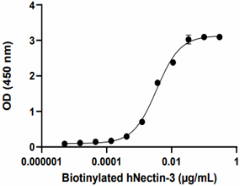- Regulatory Status
- RUO
- Other Names
- Nectin3, Nectin-3, PVRL3, PVRR3, CD113, CD113 antigen, nectin 3, poliovirus receptor-related 3, poliovirus receptor-related protein3, PPR3, PRR3CD113
- Ave. Rating
- Submit a Review
- Product Citations
- publications

-

When recombinant human Nectin-1 is immobilized at 2 µg/mL, Biotinylated Recombinant Human Nectin-3 binds in a dose-dependent manner. The ED50 for this effect is 1.4 – 8.4 ng/mL. -

Stability Testing for Biotinylated Recombinant Human Nectin-3. Biotinylated Recombinant Human Nectin-3 was aliquoted in PBS, pH 7.2 at 0.2 mg/mL. One aliquot was kept at 4°C (Control), and another was frozen and thawed four times (4x Freeze/Thaw). The samples were evaluated in a binding assay with immobilized recombinant human Nectin-1 at 2 µg/mL and different concentration of Biotinylated Recombinant Human Nectin-3 that binds in a dose-dependent manner. The ED50 for this effect is 1.4 – 8.4 ng/mL.
| Cat # | Size | Price | Save |
|---|---|---|---|
| 568204 | 25 µg | ¥63,680 | |
| 568206 | 100 µg | ¥181,090 |
Nectin cell adhesion molecule-3 (Nectin-3), also known as Poliovirus receptor-related 3 (PVRL3) and CD113, is a member of the nectin family and type I transmembrane glycoprotein. Nectin-3 belongs to the family of immunoglobulin (Ig)-like cellular adhesion molecules involved in Ca2+-independent cellular adhesion in several tissues during the development. Nectin-3 is abundantly expressed in testis, placenta, lung, liver, kidney, brain, and heart. Nectin-3 has three splicing variants, nectin-3α, -3β, and -3γ. Nectin-3 is highly expressed in epithelial cancer cells of human lung adenocarcinoma and an important player in cellular invasion by upregulating the expression of matrix metalloproteinases (MMP)-2 and -9. Nectin-3 has also been shown to trans-interact with nectin-1, thus plays a key role in the formation of synapses in the brain.
Product DetailsProduct Details
- Source
- Biotinylated recombinant human Nectin-3, amino acid Gly58-Asp400 (Accession No. Q9NQS3) was expressed in 293E cells. The C-terminal includes human IgG1-Fc-Avi tag.
- Molecular Mass
- The 603 amino acid recombinant protein has a predicted molecular mass of approximately 66.7 kD. The DTT-reduced and non-reduced proteins migrates at approximately 70 - 90 kD and 140 - 200 kD by SDS-PAGE, respectively.
- Purity
- > 95%, as determined by Coomassie stained SDS-PAGE.
- Formulation
- 0.22 µm filtered protein solution is in PBS, pH7.2.
- Endotoxin Level
- Less than 0.1 EU per µg of protein as determined by the LAL method.
- Concentration
- 25 µg size is bottled at 200 µg/mL. 100 µg size and larger sizes are lot-specific and bottled at the concentration indicated on the vial. To obtain lot-specific concentration and expiration, please enter the lot number in our Certificate of Analysis online tool.
- Storage & Handling
- Unopened vial can be stored between 2°C and 8°C for up to 2 weeks, at -20°C for up to six months, or at -70°C or colder until the expiration date. For maximum results, quick spin vial prior to opening. The protein can be aliquoted and stored at -20°C or colder. Stock solutions can also be prepared at 50 - 100 µg/mL in appropriate sterile buffer, carrier protein such as 0.2 - 1% BSA or HSA can be added when preparing the stock solution. Aliquots can be stored between 2°C and 8°C for up to one week and stored at -20°C or colder for up to 3 months. Avoid repeated freeze/thaw cycles.
- Activity
- Immobilized recombinant human Nectin-1 binds to Biotinylated Recombinant Human Nectin-3 in a dose-dependent manner. The ED50 for this effect is 1.4 – 8.4 ng/mL.
- Application
-
Bioassay
- Application Notes
-
BioLegend carrier-free recombinant proteins provided in liquid format are shipped on blue-ice. Our comparison testing data indicates that when handled and stored as recommended, the liquid format has equal or better stability and shelf-life compared to commercially available lyophilized proteins after reconstitution. Our liquid proteins are validated in-house to maintain activity after shipping on blue ice and are backed by our 100% satisfaction guarantee. If you have any concerns, contact us at tech@biolegend.com.
Antigen Details
- Structure
- Dimer
- Distribution
-
Epithelial cells, granule cells, APC, cancer cells, T-cells, and neuronal cells
- Function
- Adhesion, Ocular development involving the ciliary body
- Interaction
- T-lymphocytes, NK cell, epithelial cells
- Ligand/Receptor
- Nectin-1, -2, and -3, TIGIT, and CD155
- Bioactivity
- Measured by its ability to bind recombinant human Nectin-1
- Cell Type
- Antigen-presenting cells, Endothelial cells, Epithelial cells, Neurons, NK cells, T cells
- Biology Area
- Adaptive Immunity, Immuno-Oncology, Immunology, Innate Immunity
- Molecular Family
- Adhesion Molecules, Innate Immune Signaling
- Antigen References
-
- Takai, Y. and H. Nakanishi. 2003. J Cell Sci. 116:17-27.
- Takai Y, et al. 2008. Annual Review of Cell and Developmental Biology. 24:309-42.
- De Agustín-Durán D, et al. 2021. Cells. 10:118.
- Satoh-Horikawa K, et al. 2000. J Biol Chem. 275:10291-9.
- Inagaki M, et al. 2005. Development. 132:1525-37.
- Inagaki M, et al. 2006. Genes Cells. 11:1125-32.
- Gene ID
- 25945 View all products for this Gene ID
- UniProt
- View information about Nectin3 on UniProt.org
















Follow Us